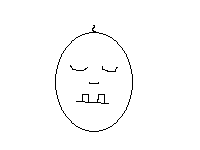Two for the price of one!
There’s two teeth there not just one! 
The Little Lovely’s daddy noticed another one coming in right next to the first. Poor boy. I wonder if it’s confusing for him to have these things suddenly appear and hurt in his mouth. No calpol, granuals or teething gel today. I did get another teether though in case it helps him. He doesn’t seem to be too interested in them though and prefers to chew on his or my hand instead.
Although he’s been drooly for a while, teething symptoms apparently occur significantly more frequently in the days before, during and after the tooth emergence (an 8-day teething period or “window” – says a recentish study (1)). Might explain some irritability and poor sleep we all had recently. The study didn’t find high fever to be associated with teething, something that I was looking out for and relying on to confirm teething! Although a mild rise in temperature was associated. Some infants had no symptoms, but they do helpfully highlight “mild symptoms” found to be temporally associated with teething including increased biting, drooling, gum-rubbing, sucking, irritability, wakefulness, ear-rubbing and facial rash. Although, no particular cluster of symptoms were found to reliably predict the imminent emergence of a tooth — so poot if I was looking for a predictive formula. oh well, only one study.
Note though symptoms are not necessarily caused by teething (they are only associated) – for example, this study (2) writes that “during this same time period of an infant’s life, passive immunity due to maternal antibodies wanes and exposure to a wide variety of childhood illnesses occurs. Due to this temporal relationship, teething often is blamed for symptoms such as changes in sleep and eating patterns, rhinorrhea, drooling, rash, fussiness, and diarrhea.”
References:
(1) Macknin et al., (2000). Symptoms Associated With Infant Teething: A Prospective Study. Pediatrics, 105 (4), pp. 747 -752
(2) Markman, L. (2009). Teething Facts and Fiction. Pediatrics in Review, 30, pp. e59 -e64
